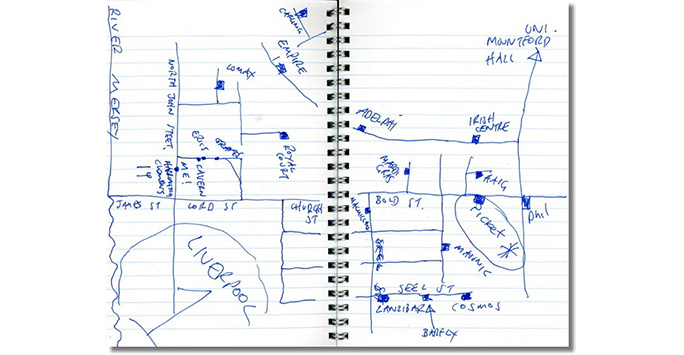Popular Musicscapes
Background
Over the past few decades the landscape and environment of many UK cities has been dramatically transformed through programmes of economic restructuring, physical regeneration and commercial investment. The impact of such changes on the cultural life of these cities has been a subject of fierce debate. Among other things, concerns have been raised about the impact of urban regeneration on spaces for live music performance and on local music scenes and creativity.
The project
Focusing on Liverpool, this project explored the relationship between music and the changing city. It considered music’s influence on the character of the city and how the city is lived, experienced and imagined, and in turn the influence of the city on music activity.
The research involved archival investigation to discover historical changes in the music places and spaces of the city, and ethnographic research with 60 musicians involved with contemporary rock, pop and hip hop music. It traced the routes of these musicians as they engaged in their regular music-making activities and explored real and imagined places connected to their music-making. This included places where their music was composed, rehearsed, performed and recorded, and places represented through their songs. In order to find out how the musicians inhabited, experienced and thought about such places it was important to talk to and hang out with them, observing and participating in their music-making activities. Among other things, this involved walking interviews with musicians and practice-based research conducted in recording studios and through live music performance.
The research also included the use of maps and map-making as a research tool. This involved mapping places of music in the city and how they had changed over time, collecting historical and contemporary maps and sharing them with musicians, mapping musicians’ journeys across the city and inviting them to draw their own memory maps of music and the city. These maps helped to prompt the telling of stories about music and the city, and their spatial, geometric patterns raised questions about music, landscape and environment.
Supported by the Arts and Humanities Research Council, the research was conducted by Sara Cohen (Principal Investigator) and Brett Lashua (Research Associate). It was based on a partnership with English Heritage (John Schofield and the Characterisation Team) and National Museums Liverpool, and involved extensive collaboration with Urbeatz, a Liverpool-based youth, media and Urban arts company.
Outcomes
The project challenged established understandings of music heritage in the city in two ways. First, it moved beyond the narrow focus on particular places and times, such as those connected to the Beatles, revealing the city’s many diverse and changing places of music. Secondly, it highlighted differences between established understandings of the city’s music heritage and musicians’ perspectives, revealing the places that matter to musicians, how and why they matter and how this changes over time. Moreover, the project showed how musicians create musical land- and soundscapes that characterise cities, but how these ‘musicscapes’ are in turn shaped by changes to the city’s landscape and environment, as well as by music genre and relations of class, ethnicity and so on.
Outputs from the project were featured as part of a major exhibition on Liverpool popular music entitled 'The Beat Goes On'. Based on collaboration between the Institute of Popular Music and National Museums Liverpool, the exhibition was launched at the World Museum Liverpool in July 2008 as part of the city's Capital of Culture celebrations and ran until November 2009, attracting a broad and diverse audience and a total of 478,188 visitors. It featured Mapping the Beat, an interactive installation, featuring six digital multi-media maps of Liverpool musicscapes incorporating images, text, sound files and interviews from the project. It was supported by The Beat Goes Online, an online resource featuring research data from the project.
Other project outcomes included commercial releases of songs created through the project and with some of the musicians involved, and numerous live performances with those musicians. They included performances at the 2009 Glastonbury festival and Liverpool Sound City festival. To mark the end of the project a public showcase was staged at Liverpool’s Bar Hannah featuring musicians who participated in the research.
The project has also resulted in numerous journal articles and book chapters, a special journal issue (Popular Music History, 4/2, 2010) and a forthcoming illustrated book (Popular Musicscapes Liverpool, Historic England, 2017). There have also been presentations at numerous academic conferences and seminars, and a symposia series that was run during the project, bringing together academics from various disciplines as well as museum staff, heritage managers and sonic artists.
The research provided the researchers with a basis for various follow-on projects:
- Oral histories and the social clubs of the African Diaspora in Liverpool (Leeds Metropolitan University and the University of Liverpool), a project involving the production of a community-based film
- The Liverpool One project involving the recording and release of an album of original material
- Popular Music Heritage, Cultural Identity and Cultural Memory (UK case study), a three-year project supported by the Humanities in the European Research Area JRP.
